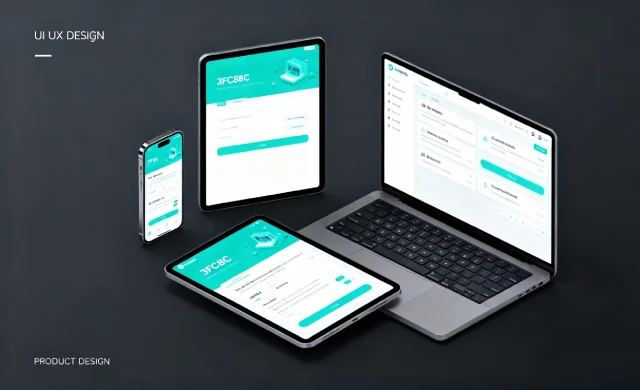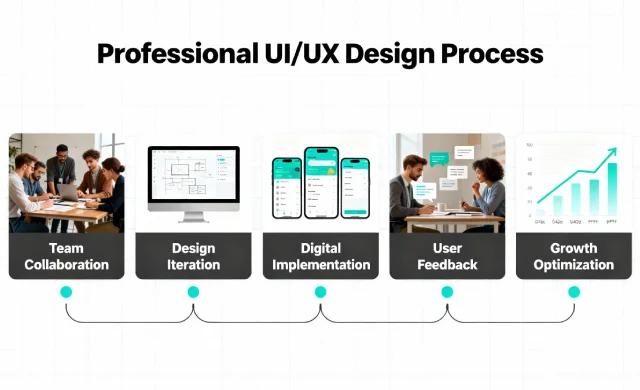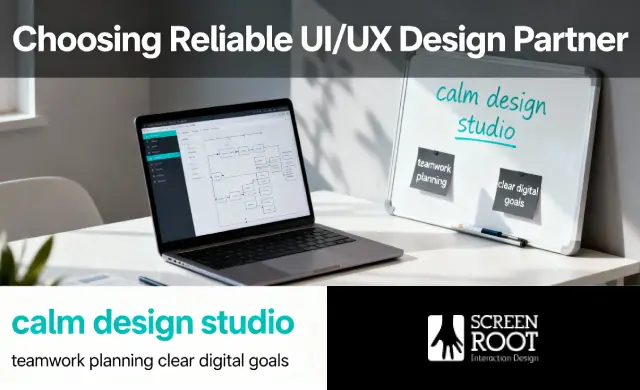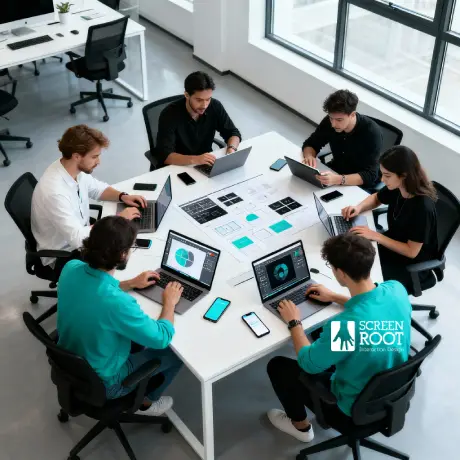Choosing the right UI UX design company can feel tricky, but it doesn’t have to be. You want a partner who improves user experience, strengthens your brand, and makes every click count. A seasoned UI UX design agency brings focused design services that turn ideas into results. They align layout, content, and user interface so journeys feel seamless and easy. They remove friction with better usability and thoughtful interface design.
Great outcomes start with a clear design process. Teams map flows, build intuitive screens, and test early. The goal is a stronger digital experience for web, mobile, and more. Expert ui design supports any digital product you run today or plan tomorrow. With usability testing, they validate choices with real people. That’s how user-centric decisions stick.
You also need a capable design team. They improve user engagement through simple content, clean visuals, and fast paths to value. The best work is collaborative and tied to business goals. It blends design expertise with clear metrics. It also welcomes innovative design where it helps most. You get structured web design, smart product design, and evidence-based UX research.
This article shows how a UI UX design company plans, builds, and ships work that lasts. You’ll see how to brief well, choose the right partner, and measure impact. If you want fewer drop-offs and happier users, you’re in the right place. Let’s begin.

What a UI/UX Design Company Delivers
A great product feels effortless. That’s the promise of a skilled UI UX design company. It blends research, creativity, and testing into work that simply makes sense. Pages feel smooth. Journeys feel short. And results improve. When teams design with intent, your digital experience meets users where they are. On any device. In any moment. That’s where growth begins.
What We Mean By a UI/UX Design Company
It’s a specialist agency that plans and shapes how products look and work across web and mobile. It turns needs into clear screens and simple paths. It focuses on user interface design and the flow behind it so people can do tasks with less effort. UX and UI work together to guide the journey and the on-screen details.
Core Services, in Plain Words
They start with UX research to learn what people need and how they behave. Then come wireframes and prototypes to map ideas. These blueprints show layout and structure before pixels get polished.
Next, UI design adds visual clarity and hierarchy. Interaction patterns make each tap or click feel natural. Designs then go through usability testing with real people. Teams watch what works, fix what doesn’t, and test again.
Finally, it all adapts to screens of every size. Mobile UI and web design follow responsive principles so layouts adjust and stay readable. That way, journeys remain seamless and intuitive on phones, tablets, and desktops.
Why These Services Matter
Together, they reduce friction and shorten paths to value. People find what they need faster. Task success rises. User engagement improves because the experience respects time and context. Evidence-led methods keep changes focused on what helps users most.
Why Hire a Company Instead of Going Ad-hoc
Ad-hoc design often skips steps and guesses at solutions. A mature design process brings structure, shared language, and repeatable wins. It means fewer reworks, clearer decisions, and steady improvements over time. In short, you get design solutions that scale with your product and your plans.

Benefits of Hiring Professional UI/UX Design Services
Design lifts results when it’s planned, tested, and cared for. Hiring a UI UX design company aligns teams around clear goals and a simple path. You get focused UI UX design services guided by a practical design process. These are the hallmarks of the best UI UX design. The outcome feels seamless and intuitive across screens. People stay longer, and you waste less time. That momentum powers user engagement and steady business growth.
1. Engagement Up, Drop-offs Down
Cleaner flows reduce effort. People complete tasks instead of bailing. Industry research shows cart abandonment averages ~70%, so fixing friction matters. Teams that test changes with users and track metrics see measurable gains from data-driven design.
2. Stronger Brand Perception & Trust
Consistency builds confidence across touchpoints. When web design and apps look and behave the same, enhance user trust and the brand feels reliable. Responsive foundations keep layouts aligned on different screens, which supports recognition and credibility. Responsive patterns ensure a seamless experience as screens and features grow.
3. Higher Conversions & Better ROI
Design-led companies outperform peers. McKinsey found top-quartile design performers grow revenue and shareholder returns much faster. Even small mobile speed gains lift conversions, proving the link between UX quality and outcomes.
4. Less Rework, Lower Build Costs
Catching issues early costs less than fixing code later. Prototypes and usability testing surface blockers before development hardens. Long-running studies from NN/g show usability investments continue to pay back strongly.
5. Adaptable Across Devices & Platforms
Good systems flex as you grow. Solid mobile UI patterns and responsive layouts scale from phone to desktop without breaking. Google and NN/g outline the fundamentals that keep experiences coherent as features expand.
6. The Cost of Getting it Wrong
Skipping specialists risks cluttered paths, slow pages, and churn. Slow mobile pages can dent conversions; rivals that invest in design compound gains over time. The gap shows up in market results.
Bottom line: Treat expert design as a growth lever, not an expense.

How to Select the Right UI UX Design Company
Choosing a UI UX design company is like picking a long-term partner. The right team listens, then shapes a clear plan around your business goals. They bring a practical design process and a calm, reliable design studio vibe. Results follow. Paths get shorter. Interfaces feel natural. Your risk drops, while confidence grows across every screen.
1. Define Scope, Goals, Timeline, Budget
Write the essentials first. Describe users, success metrics, and must-have features. Tie each item to outcomes, not wish lists. Use a few measurable targets for design projects so progress stays visible. Clear inputs keep trade-offs honest and decisions faster. That focus protects value.
2. Review Portfolios & Case Studies
Scan real work across web and mobile app contexts. Look for clean UI, solid flows, and measurable results. Fewer, deeper case studies beat glossy slides. You want narrative, constraints, and impact. That shows thinking, not just polish, and signals a dependable design studio mindset.
3. Check Testimonials & Reviews
Read what clients say about delivery, clarity, and customer satisfaction. Favor specifics over praise. Look for outcomes tied to metrics, like engagement or task success. When stories match portfolio claims, trust rises. Numbers help too, especially when they relate to the goals you set earlier.
4. Assess Expertise & Experience
Ask about the design team, toolchain, and cross-platform skills. Can they shape mobile UI and desktop with equal care? Do they understand accessibility and performance? Teams fluent in responsive principles carry patterns safely across devices and viewports. That keeps layouts coherent as features grow.
5. Interview & Request Proposals
Meet the people who’ll do the work. Discuss user research, prototyping, and usability testing. Ask how they validate ideas and fix friction early. Then request a clear plan with deliverables, milestones, and pricing. Agencies that test with users make better choices and avoid guesswork. That saves time and cost.
Portfolio & Track Record Review
You want evidence across platforms and domains, plus outcomes like improved conversions or time on site. Strong case studies explain constraints, process, and impact. They also show pattern reuse without copy-paste. That mix proves repeatable judgment, not luck.
Process, Pricing and Collaboration Fit
Confirm how they discover needs, model journeys, and test early. Early testing cuts rework, which protects budgets. Clarify communication rhythms and who signs off what. Understand pricing models before you start. A team that iterates quickly will adapt with you as priorities shift.
The right partner gives you steady craft, honest data, and calm delivery. Good habits stack: clearer decisions, faster releases, fewer surprises. Teams that follow the best UI UX design principles make clearer decisions and ship with confidence. That foundation supports growth now and leaves room to scale services and development services later, without redesigning from scratch.

What to Expect When Working With a UI UX Design Company?
Working with a UI UX design company feels calm and organized. You meet a team that listens first, then shapes a practical plan. They blend research, craft, and checks with real people. Screens get simpler. Paths get shorter. And, most importantly, outcomes line up with your goals across web and mobile. That’s the promise when the right people run a clear design process.
Kick-Off & Discovery
Everything starts with a shared picture of success. Teams gather requirements, align on users, and agree goals, scope, and risks. They map constraints early, so choices later stay grounded. Clear discovery reduces surprises and sets up smoother delivery across phases. It’s the project’s compass.
Research & User-Personas
Lightweight studies reveal needs, tasks, and user behavior. Personas convert that insight into a human snapshot the design team can rally around. They’re optional, yet useful for empathy and decision-making when rooted in evidence. Keep them current, and link them to measurable outcomes. That’s how they guide real work.
Wireframes & User-Flows
Early sketches show structure, navigation, and key steps before polish. Teams explore options, compare paths, and fix blockers cheaply. Clear flows support interface design that feels natural later. Wireframes keep everyone honest about priorities and effort, long before budgets lock in. Think scaffolding, not finished walls.
Visual UI Design
Now the look and feel take shape. Designers apply design principles, spacing, and hierarchy, then align colors and type with brand. Components form a simple design system that scales. Good UI design clarifies actions, reduces noise, and keeps pages consistent across journeys. Beauty serves use, not the other way round.
Prototyping & Usability Testing
Clickable demos make ideas tangible. Teams watch real user sessions to see what sticks and what stalls. Small fixes land fast; bigger issues get reshaped. This loop keeps choices honest and data-driven design on track, long before code hardens. It’s cheaper to adjust now than later. It’s the path to top UI UX design.
Handoff & Development Support
Designers package specs, tokens, and assets to ensure engineers build with fewer questions. Clear annotations, measurements, and file structure reduce churn in design and development. Tools like Figma’s Dev Mode smooth collaboration for web and mobile app delivery. Less ambiguity. More momentum. Faster releases.
Iteration & Optimization Post-Launch
Launch isn’t the finish line. Teams monitor behavior, spot friction, and refine flows to boost user engagement. Small, regular updates protect quality and keep pace with change. Agile cycles encourage steady improvement, so the product stays useful and healthy over time. Measure, learn, and adjust. Repeat.
What Good Collaboration Looks Like
Expect regular check-ins, transparent notes, and shared milestones. Roles and decisions are clear, so feedback moves quickly. A collaborative rhythm keeps scope visible and trade-offs fair. Even better, it creates trust, as your team, UI UX designers, and engineers move in step, not at odds. That’s how momentum grows.
Common Pitfalls To Avoid
Vague briefs invite rework. Scope creep hides real priorities. Ignoring mobile UI harms reach. Skipping usability testing turns guesses into expensive fixes. Keep goals tight, test early, and revisit assumptions as you learn. This discipline saves time and money, and protects quality where it matters.
The Payoff
With a clear path and steady habits, you get a seamless and intuitive experience that people enjoy using. The result feels beautiful and useful, not merely styled. Done well, the process also reduces risk and supports growth, both today and as features expand. That’s the quiet power of good design.

Frequently Asked Questions About UI/UX Design Agencies
Thinking about hiring a UI UX design company? Here are quick answers to common questions, so you can move ahead with clarity. Especially if you’re considering ScreenRoot.
What’s the Difference Between UI and UX?
UI is the user interface you see and use. UX is the overall user experience design that makes the journey work. UI handles look and interaction on each screen. UX covers the bigger flow, from first tap to final task. Both succeed together.
How Long Does a UI/UX Design Project Take?
Timelines depend on scope and risk. Small features can finish in weeks. Larger products often run a few months from discovery to release. Time grows with research depth, number of screens, and testing. Clear goals keep the schedule honest.
How Much Does it Cost?
Budgets vary with complexity, deliverables, number of screens, and whether you need research, audits, or usability testing. Ask for a proposal that links scope, milestones, and price.
Can The Work Adapt to Different Devices & Platforms?
Yes. Responsive foundations keep web and mobile app experiences consistent. Good patterns scale across screens, to ensure layouts stay clear and actions remain easy. ScreenRoot’s process focuses on flexible design that holds up as features grow.
How Will I Measure Success?
Tie outcomes to user engagement and business results. Use user research, usability testing, feedback, and analytics to guide updates. This data-driven design loop shows what works, then helps you improve it over time. ScreenRoot follows the same approach.

Why ScreenRoot Is Your UI/UX Design Partner
Choosing a partner should feel easy. ScreenRoot makes it that way. As a leading UI UX design company, we help teams ship work that looks good and works even better. We blend calm craft with clear outcomes. Web, mobile, or the next device, your digital product stays coherent, quick, and human. You get measurable progress without the drama.
Built for The Web, Mobile, & What’s Next
ScreenRoot works across web design, mobile UI, and next-gen interfaces, so your roadmap isn’t boxed in. The design team covers research, audits, workshops, and product innovation. One design studio with a wide range of services that scale as you grow. Consistency holds across channels and states, from first click to repeat use.
Beauty Plus Ease, Not One or The Other
You get interfaces that are attractive and simple to use. The focus is user experience and user interface working together, so flows feel seamless and intuitive. ScreenRoot’s promise is clear: designs people enjoy using, built to perform, not just to impress. We aim for the best UI UX design on every release.
A Proven, End-to-End Process
Work follows a steady path: discovery, UX research, wireframes, UI design, prototypes, usability testing, launch, and ongoing optimize. Each step trims risk and guides decisions with evidence, not hunches. That rhythm keeps teams aligned and momentum high from brief to release.
Outcomes That Matter to The Business
Case studies show simpler journeys, faster checkouts, and stronger user engagement, the kind of shifts that lift conversions and cut rework. Insight from real use steers upgrades that stick, so you spend less fixing and more shipping.
The Smart Investment: Everything in One Place
You get design services under one roof, research, interface design, audits, and product design, with tight handshakes into design and development. That unity saves time, avoids gaps, and protects consistency across devices. It’s practical design expertise for today’s needs and tomorrow’s changes.
Let’s Build What Your Users Expect
Ready to talk? Book a quick discovery call or drop a line. Partner with a top UI UX design agency today. Email [email protected] or call 1800 121 5955. Prefer WhatsApp or the Contact Form? Leave a note; our team will call back promptly. We’ll tailor a clear plan to your business goals, keep it collaborative, and deliver an experience your customers actually use, shaped by top UI UX design day after day.







